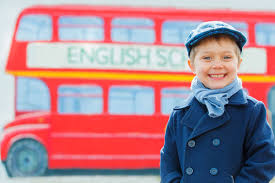It can be difficult growing up as a bilingual child, but the benefits of learning a second language as a child are really worth it. Bilingual children learn faster and easier, have more creativity and problem-solving skills, and often have more opportunities to find work as adults. It is also easier for them to connect with other cultures, which makes them more open-minded and tolerant. Added to all this is that learning a second language as a child decreases the probability of suffering a mental illness when they grow up, and that it is much easier to learn a second language as a child.

Also, learning a second language is not as difficult as it used to be. Scientists are constantly studying second language acquisition, and are developing new methodologies that help them learn faster. Furthermore, the growing demand for language courses has created a whole new market for international summer camps with language classes where children can enjoy their favorite activities and learn a new language at the same time.
The benefits of learning a second language as a child are:

- Learn faster and easier
- Improve problem solving and creativity
- Increase job opportunities
- Connect with other cultures and create tolerance
- Prevent age-related mental illness
Learning a second language is easier as a child
One of the main benefits of learning a language as a child is that they learn other languages easier and faster. They have more time to learn, less content, fewer restrictions, and a brain designed to learn languages. In short, teaching your child a second language as a child prevents them from having to learn it as an adult.
1. The brain structure facilitates the learning of the second language
On a biological level, children are like sponges. A child’s brain is designed to absorb new information unconsciously, similar to the way adults unconsciously learn lyrics, rhythms, and melodies. Dr. Paul Thompson, a UCLA professor of neurology, discovered with his team that brain systems that specialize in learning new languages grow faster between 6 years and puberty. Later, these systems basically stop growing from 11 to 15 years old, during puberty. Click HERE to read more about the study.
2. Babies’ brains have special skills for learning a second language

Take a look at this TED talk where Patricia Kuhl explains how babies listen to the sounds around them and “make statistics” about the sounds they should know. Before 10-12 years, babies can differentiate all the sounds of each language. Then, based on their exposure to languages, they begin to differentiate between the language sounds that are necessary to create meaning. Japanese does not differentiate between L and R sounds . Japanese babies under the age of 10 months can perceive the difference between the two sounds. Then, between 10 and 12 months, they lose their ability to tell it apart.
Can a baby learn a new language with radio and television? Or do they need real human interaction to absorb a new language? You can skip to 7:05 until you find out.
3. Children have less to learn than adults
Another benefit of learning a second language as a child is that children think more simply than adults. They use fewer words, simpler sentences, and less abstract ideas. Children who are learning a second language are not overwhelmed by having to communicate their abstract thoughts and feelings in their second language because they simply are not aware of them. Later, as they develop as adults, they learn to express themselves in both languages (native and second language). Adults, on the other hand, face the difficult task of translating complex sentence structures and abstract thoughts to be able to fully express themselves in their second language.
4. Children have more time
Think about the books you have read as a child compared to the ones you read now. Remember that you needed years of study and a lot of reading until you were able to understand the texts that you are able to read now. The same applies to writing, listening, and even speaking. It took you at least 15 years of academic study to be able to communicate the way you do now in your own native language. Time is another benefit of learning a second language as a child: they can start a small, simple job and climb to higher levels of thinking and communication at the same time. Children have a great advantage over adults when learning a second language.
Learning a second language makes children adept at problem solving
When you learn a second language as a child, you grow up with an expert mind in creativity and problem solving. The brain undergoes constant training from an early age as they try to choose which language to speak and when. Researchers have found that, in addition to problem-solving skills, bilingual children are better at planning, concentrating, and multitasking. They also tend to get better grades on exams. By teaching him a second language as a child, you are leading his career to success.
5. Learning a second language involves constant mental training
Bilinguals experience constant mental work as they choose between more than one language system to communicate. In the 20th century, researchers and educators discouraged learning a second language, saying that it interfered with children’s cognitive and intellectual development. Although there is evidence that bilingual children experience this interference in their language systems, it has been found that the bilingual experience prepares them to be adept at problem solving. Click here to read the full article.
6. Learning a second language means improving executive function
There is collective evidence among several studies that shows that learning a second language as a child improves executive function of the brain , which means that it makes children better at:
- Organization
- Problem resolution
- Concentration
- Multitask
An interesting study:
In 2004, psychologists Ellen Bialystok and Michelle Martin-Rhee tested the problem-solving skills of bilingual and monolingual preschool children. All were asked to sort blue circles and red squares into two digital boxes on a computer screen – one marked with a blue square and one with a red circle.
First, they were asked to separate the figures by color, putting the blue ones in the blue box and the red ones in the red box. Both groups did well.
Then they were asked to organize them by shape, putting the blue circles in the red circle box, and the red squares in the blue square box. This task required more concentration since the children had to organize the figures in a box and ignore the color difference. Bilingual children completed the task more quickly.
7. Learning a second language is related to better grades
Another of the many benefits of learning a second language as a child is the improvement in their grades. Students who learn other languages score better on tests . In fact, students’ grades are directly proportional to the amount of time they have spent studying a second language. To read more research on the effects of learning a language as a child on academic performance, click HERE .
8. Learning a second language encourages creative thinking

The increase creativity is another of the benefits of learning a second language as a child . Several studies support this theory.
One of the most widely used tests for measuring creativity is called the Torrance Creative Thought Test, created by Ellis Paul Torrance in 1962. These tests are designed to measure “divergent thinking” or thinking outside the box (creative thinking), and They measure it in four areas: fluency, flexibility, originality and elaboration.
Bilingual children performed better on the test.
9. Learning a second language develops divergent thinking
Bilingual children learn to see the world with different eyes. Therefore, they have at their disposal different points of view that allow them to be able to think creatively. When we talk about “seeing the world with other eyes”, we mean that each language we learn presents us with new obstacles when it comes to expressing ourselves. For example, Turkish and Russian do not have an equivalent translation for English verbs “to have ”and“ to be ”- some of the most common verbs in everyday speech. When the minds of bilingual people look for ways to overcome these barriers, they become embroiled in intensive divergent thinking – the same that stimulates creativity.
Interesting fact:
With the advancement of technology in today’s world, machines cover more and more complex tasks such as translating texts or diagnosing diseases. According to The Economist , 47% of America’s jobs are vulnerable to automation. In poor countries like India and Ethiopia, these numbers are even higher.
Can you say why the jobs of poor countries are more vulnerable?
Rich countries have more difficult jobs for machines. Occupations that require original ideas (such as advertising) or complex social interactions (such as a judge, a lawyer …) are tasks that can only be performed by humans (at least, for now).
In times like this, CREATIVITY is more IMPORTANT than ever.
Learning a second language as a child prepares children for the world of work
10. Learning a second language leads to more job opportunities

In the modern era of globalization, more and more companies are looking for employees who speak multiple languages. Additionally, employees who speak multiple languages tend to have a significantly higher salary than monolinguals.
This demand for jobs goes beyond positions such as translation and interpretation. Companies need employees who can communicate without borders, in order to internationalize their products and services. This means that companies often look for employees capable of translating into one or more languages and who are specialized in a specific field. Bilingual individuals with experience in a legal, medical, technical, or scientific field can find well-paying jobs translating and interpreting.
This is great news for bilingual children growing up in a bilingual home or exposed to multiple languages from a young age. Since children learn languages much faster than adults, they can learn a second language while they are young so they can focus on specializing in a specific field that may interest them in college. These bilingual specialists can then earn a lot of money translating texts related to their field.
If these children become translators or interpreters in a specific field or find a job in their field identifying themselves as bilingual, their wages will be much higher than that of their monolingual peers.
Learning a second language helps connect with other cultures

11. Bilingual children have more opportunities to travel at maturity
One of the most exciting benefits of learning a second language as a child is the ability to communicate with more people from different cultures. Children who learn a second language will have an incredible opportunity to travel the world and learn about other cultures.
English has become the lingua franca of the world, which means that it is the common language that people use to communicate when they do not share any native language. Today, many young people around the world have a good understanding of English. That being said, children who speak English natively are extremely lucky. As they grow into adulthood, they will be able to travel to many places and communicate with many people around the world, learning to tolerate and appreciate cultural differences.
The following image presents a top of the 10 countries with the best English as a second language:
However, many precious countries rich in culture and tradition are somewhat below the best English speaking index, and even the countries at the top of the list can only be in the big cities where tourism has become very important. for the economy. It’s much easier to explore small towns, participate in their cultural rituals and ceremonies, and truly connect with people from other cultures when you speak their language.
Look at the following images to see the level of English proficiency in countries around the world:
Luckily, native English speakers can choose their second language.
Native English speakers also have a second advantage: while the rest are basically required to know English as a second language, native English speakers have more freedom to choose which language they want to study as a second language.
For children, the choice of language to be learned really depends on their parents. Parents whose native language is not English often teach their children their own language. By doing this, it is easier to be part of the child’s learning process: these parents, for example, do not need to hire native teachers to talk to their children. Plus, your kids can connect to their own legacy more easily.
Instead, for children coming from monolingual English families, parents often have to decide which language they would like to learn from a wide variety of possibilities. Should they learn Spanish? Mandarin? Portuguese? Arab? Some languages are more popular and useful than others worldwide.
The following image shows the most popular countries on each continent worldwide:
12. Learning a second language prevents degenerative mental illness

Many studies start from the hypothesis that people who speak a second language normally delay Alzheimer’s disease an average of 4.5 years .
A new study published in the journal Neuropsychologia reveals that bilingualism creates changes in the structure of the brain that are related to a resilience against Alzheimer’s disease and other mild cognitive impairments.
The explanation the researchers give about this fact is that it is due to the constant work that a bilingual brain experiences while constantly filtering information in two different languages.
Click here to read the entire article.
What have we learned? – 12 key points
The 5 main benefits of learning a second language as a child help:
- Learn faster and easier
- Improve problem solving and creativity
- Increase job opportunities
- Connect with other cultures and create tolerance
- Prevent age-related mental illness
And here is why:

- Our brains are designed to learn languages until they reach puberty. It is a good idea to start learning it as soon as possible.
- Babies can differentiate all the sounds of a language before 10-12 months. Then they lose this ability according to the sounds they consider useful (their own language). Also, it’s good to be exposed to multiple languages to maintain this skill.
- Children think more simply, so they have less to learn. They are not saturated when they try to communicate complex thoughts, unlike adults.
- Children have much more time to dedicate to learning the language. Learning is their only “job” throughout the day.
- Bilingual brains experience mental growth and non-stop work.
- This brain exercise leads to better organization, problem solving, concentration and multitasking skills.
- This brain exercise also contributes to divergent thinking – “out of the box” thinking and problem solving skills.
- Bilingual children are more creative.
- Learning a second language as children makes you get better grades in your childhood and adolescence.
- As they get older, their bilingualism can help them get better jobs and better wages.
- They will also have more opportunities to travel, connect with their heritage and learn about other cultures.
- Finally, as they approach old age, their bilingualism may slow the onset of Alzheimer’s disease by up to 4.5 years
